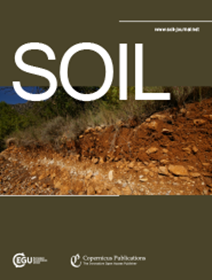利用蒙特卡罗保形预测方法评价深度学习土壤光谱模型的不确定性
IF 5.8
2区 农林科学
Q1 SOIL SCIENCE
引用次数: 0
摘要
摘要。不确定性量化是土壤光谱模型实际应用的关键步骤,特别是在支持现实世界的决策和风险评估方面。虽然机器学习在利用光谱学预测土壤的各种理化性质方面取得了显著进展,但缺乏量化不确定性的预测在指导关键决策方面的效用有限。然而,不确定性量化在土壤光谱模型报告中仍未得到充分利用,现有方法面临重大局限性。这些方法要么在计算上要求很高,要么无法实现观测数据的预期覆盖,要么难以有效地处理域外不确定性。本研究介绍了蒙特卡罗保形预测(MC-CP)的创新应用,作为一种新的方法来量化中红外光谱预测粘土含量的不确定性。我们将MC-CP与两种已建立的方法(1)Monte Carlo dropout和(2)适形预测进行了比较。蒙特卡罗dropout为每个样本生成预测区间,并有效地解决与域外数据相关的较大不确定性。然而,它没有达到预期的覆盖率——其90%的预测间隔只覆盖了74%的情况下的观测值,远低于预期的90%的覆盖率。另一方面,保形预测保证了真值的理想覆盖,但产生了不必要的宽预测区间,使其在许多实际应用中过于保守。相比之下,MC-CP成功地结合了两种方法的优势。它实现了91%的预测区间覆盖概率,与预期的90%覆盖率非常接近,远远超过了蒙特卡罗dropout的性能。此外,MC-CP的平均预测区间宽度为9.05%,比适形预测的11.11%窄,同时仍然有效地解决了域外样本中较高的不确定性。通过生成准确的预测区间和点预测,MC-CP展示了其提供实用可靠的不确定性量化的能力。这一突破增强了土壤光谱模型在现实世界中的适用性,代表了土壤科学领域的重大进步。MC-CP的成功为其集成到大规模机器学习模型(如土壤推理系统)铺平了道路,进一步革新了土壤科学中的决策和风险评估。本文章由计算机程序翻译,如有差异,请以英文原文为准。
Using Monte Carlo conformal prediction to evaluate the uncertainty of deep learning soil spectral models
Abstract. Uncertainty quantification is a crucial step for the practical application of soil spectral models, particularly in supporting real-world decision making and risk assessment. While machine learning has made remarkable strides in predicting various physiochemical properties of soils using spectroscopy, predictions devoid of quantified uncertainty offer limited utility in guiding critical decisions. However, uncertainty quantification remains underutilised in the reporting of soil spectral models, with existing methods facing significant limitations. These approaches are either computationally demanding, fail to achieve the desired coverage of observed data, or struggle to handle out-of-domain uncertainty effectively. This study introduces the innovative use of Monte Carlo conformal prediction (MC-CP) as a novel approach to quantify uncertainty in the prediction of clay content from mid-infrared spectroscopy. We compared MC-CP with two established methods: (1) Monte Carlo dropout and (2) conformal prediction. Monte Carlo dropout generates prediction intervals for each sample and is effective at addressing larger uncertainties associated with out-of-domain data. However, it falls short in achieving the desired coverage – its 90 % prediction intervals only covered the observed values in 74 % of cases, well below the expected 90 % coverage. Conformal prediction, on the other hand, guarantees ideal coverage of true values but generates unnecessarily wide prediction intervals, making it overly conservative for many practical applications. In contrast, MC-CP successfully combines the strengths of both methods. It achieved a prediction interval coverage probability of 91 %, closely matching the expected 90 % coverage, and far surpassing the performance of Monte Carlo dropout. Additionally, the mean prediction interval width for MC-CP was 9.05 %, narrower than conformal prediction’s 11.11 %, while still effectively addressing the higher uncertainty in out-of-domain samples. By generating accurate prediction intervals alongside point predictions, MC-CP demonstrated its ability to deliver practical and reliable uncertainty quantification. This breakthrough enhances the real-world applicability of soil spectral models and represents a significant advancement in the field of soil science. The success of MC-CP paves the way for its integration into large-scale machine-learning models, such as soil inference systems, further revolutionising decision-making and risk assessment in soil science.
求助全文
通过发布文献求助,成功后即可免费获取论文全文。
去求助
来源期刊

Soil
Agricultural and Biological Sciences-Soil Science
CiteScore
10.80
自引率
2.90%
发文量
44
审稿时长
30 weeks
期刊介绍:
SOIL is an international scientific journal dedicated to the publication and discussion of high-quality research in the field of soil system sciences.
SOIL is at the interface between the atmosphere, lithosphere, hydrosphere, and biosphere. SOIL publishes scientific research that contributes to understanding the soil system and its interaction with humans and the entire Earth system. The scope of the journal includes all topics that fall within the study of soil science as a discipline, with an emphasis on studies that integrate soil science with other sciences (hydrology, agronomy, socio-economics, health sciences, atmospheric sciences, etc.).
 求助内容:
求助内容: 应助结果提醒方式:
应助结果提醒方式:


